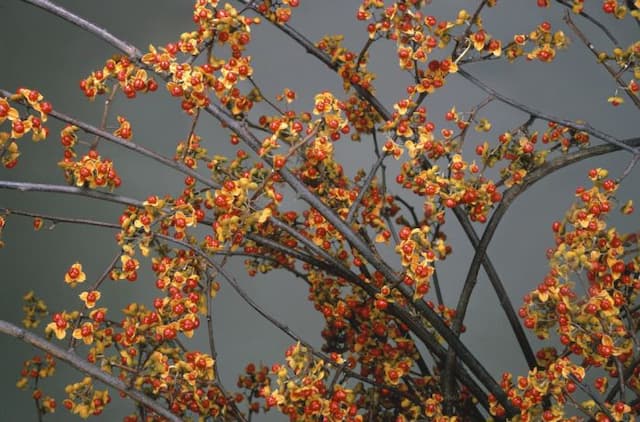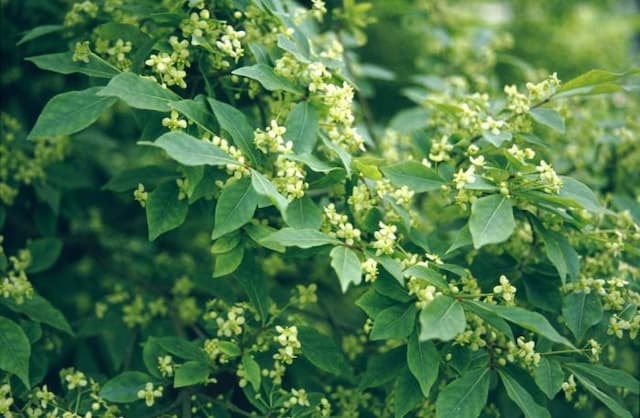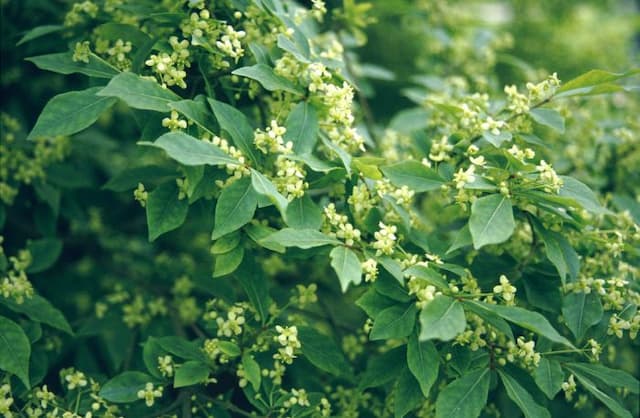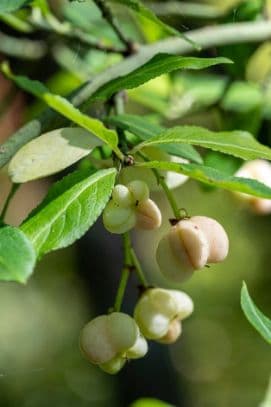Golden Euonymus Euonymus japonicus 'Ovatus Aureus' (v)

ABOUT
The plant commonly known as Golden Japanese Spindle is an evergreen shrub that is highly appreciated for its ornamental foliage. The leaves are glossy and exhibit a broad, gold margin that contrasts beautifully with the green center. This variegated pattern gives the foliage a vibrant and eye-catching appearance. The shape of the leaves tends to be oval, adding to the lush look of the shrub. Over the seasons, the leaves maintain their color, which helps to create a consistent visual interest in gardens where the Golden Japanese Spindle is planted. This makes it a popular choice for gardeners who are seeking plants that provide year-round ornamental value without significant fluctuations in appearance.
About this plant
 Names
NamesFamily
Celastraceae.
Synonyms
Golden Euonymus, Japanese Spindle, Evergreen Spindle, Japanese Euonymus.
Common names
Euonymus japonicus 'Aureovariegatus', Euonymus japonicus 'Aureo-variegatus'.
 Toxicity
ToxicityTo humans
The plant commonly known as Japanese Spindle is considered toxic to humans. Consumption of any part of this plant can cause symptoms such as nausea, vomiting, diarrhea, weakness, and chills. Ingesting larger amounts of the plant can lead to more severe symptoms, including a change in heart rate, convulsions, and in extreme cases, it could potentially be life-threatening. Therefore, care should be taken to prevent accidental ingestion, especially by children.
To pets
The Japanese Spindle is also toxic to pets. If animals ingest parts of this plant, they may exhibit symptoms similar to those in humans, including vomiting, diarrhea, abdominal pain, and weakness. In severe cases, ingestion can lead to more serious issues such as heart problems, respiratory difficulties, or seizures. It is crucial to keep this plant out of reach of pets to prevent poisoning. If you suspect your pet has ingested Japanese Spindle, seek veterinary care immediately.
 Characteristics
CharacteristicsLife cycle
Perennials
Foliage type
Evergreen
Color of leaves
Variegated
Height
6 feet (1.83 meters)
Spread
6 feet (1.83 meters)
Plant type
Shrub
Hardiness zones
6
Native area
Japan
Benefits
 General Benefits
General Benefits- Ornamental Appeal: Provides year-round visual interest with its evergreen foliage and variegated gold and green leaves.
- Low Maintenance: It's a hardy plant that requires minimal care once established, needing only occasional pruning to maintain shape.
- Drought Tolerant: Once established, it can tolerate periods of low water, making it suitable for water-efficient landscapes.
- Versatile Landscaping: Can be used for hedges, foundation plantings, borders, and as a stand-alone specimen.
- Adaptable to Soil Types: Thrives in a wide range of soil conditions, which makes it suitable for different garden setups.
- Pest Resistance: Generally resistant to pests and diseases, reducing the need for chemical treatments.
- Privacy Screen: When grown as a hedge, it can provide privacy to yards and garden areas throughout the year.
 Medical Properties
Medical PropertiesThis plant is not used for medical purposes.
 Air-purifying Qualities
Air-purifying QualitiesThis plant is not specifically known for air purifying qualities.
 Other Uses
Other Uses- Euonymus japonicus 'Ovatus Aureus', also known as Golden Euonymus, is often used in topiary gardens due to its dense foliage that can be sculpted into various shapes.
- Golden Euonymus can serve as a natural fence or screen when planted in rows, providing privacy and reducing noise from streets and neighbors.
- Due to its vibrant color, it's used in color-themed gardens to create striking contrasts with darker-leaved plants or complement other golden-hued plants.
- In coastal areas, Golden Euonymus is used for landscaping as it is tolerant of salt spray and can help stabilize sandy soils.
- Golden Euonymus, being evergreen, can be planted on slopes to prevent soil erosion, providing year-round coverage and root stability.
- The plant can be used as a backdrop in photography, especially in gardens, due to its bright and consistent foliage which provides a lush green setting.
- Golden Euonymus can be utilized in festive decorating, particularly during the fall season, as its leaves hold their color and add natural ornamentation to outdoor displays.
- They can act as a natural reflector in darker areas of the garden, as the bright variegated leaves can bounce light into shaded spots.
- This plant's leaves can be used in crafts, such as leaf printing or stamping, to create botanical patterns and designs on paper and fabric.
- In landscape designing, Golden Euonymus can be planted in geometric patterns or knot gardens for formal garden aesthetics thanks to its uniform growth habit.
Interesting Facts
 Feng Shui
Feng ShuiThe Golden Euonymus is not used in Feng Shui practice.
 Zodiac Sign Compitability
Zodiac Sign CompitabilityThe Golden Euonymus is not used in astrology practice.
 Plant Symbolism
Plant Symbolism- Longevity: Often used in landscaping for their durability, Euonymus japonicus 'Ovatus Aureus', commonly referred to as the Golden Euonymus, symbolizes longevity and endurance due to its hardy nature and ability to thrive in various conditions.
- Stability and Fidelity: With its robust and evergreen presence, the Golden Euonymus stands for stability and fidelity, making it an ideal plant to represent steadfast aspects in life such as long-lasting relationships or unwavering principles.
- Prosperity: The vibrant gold-variegated leaves are sometimes associated with prosperity and success, reflecting the idea that the plant's vivid appearance can attract wealth and positive energy.
- Protection: In some cultures, the dense growth of the Golden Euonymus has made it a symbol of protection, as it is thought to shield and safeguard homes and gardens against negative forces.
 Water
WaterThe Golden Euonymus requires consistent moisture, but it is important not to overwater. During the growing season in spring and summer, water the plant deeply once a week, ensuring that the soil is moist but not soggy. Each watering session should provide enough water to penetrate the top inch of soil. In the fall and winter, reduce watering to every two weeks or when the top inch of soil feels dry. Depending on the size of the plant and the environmental conditions, this could mean using between half a gallon to one gallon of water at each watering session.
 Light
LightThe Golden Euonymus thrives in full sun to partial shade. It is best to place the plant in a spot where it will receive at least four to six hours of direct sunlight per day. If grown indoors, a south-facing window is an excellent location to ensure it gets enough light. However, in extremely hot climates, some afternoon shade will help prevent leaf scorch.
 Temperature
TemperatureThe Golden Euonymus is hardy and can tolerate a range of temperatures, from hot summers to cold winters. It can survive in temperatures as low as 10°F and as high as 90°F. However, the ideal temperature range for this plant is between 60°F and 80°F for optimal growth. It is important to avoid sudden temperature extremes, which can stress the plant.
 Pruning
PruningPruning the Golden Euonymus helps maintain its shape, encourages bushier growth, and removes any dead or damaged branches. Prune in late winter or early spring before new growth starts. Clip the plant to shape as desired and remove any excess growth to create a clean outline. Pruning can be done annually or as needed to maintain the desired size and shape.
 Cleaning
CleaningAs needed
 Soil
SoilThe Golden Euonymus thrives in well-draining soil that is rich in organic matter, with a preferred pH range of 6.0 to 7.5. A mix of two parts loam, one part peat moss, and one part perlite or sand is ideal, ensuring good drainage and aeration.
 Repotting
RepottingGolden Euonymus should be repotted every 2-3 years to replenish the soil and accommodate its growth. Use a slightly larger pot each time to allow for root expansion.
 Humidity & Misting
Humidity & MistingGolden Euonymus is tolerant of a wide range of humidity conditions but prefers moderate humidity levels. It can adapt to the average indoor humidity without needing special attention.
 Suitable locations
Suitable locationsIndoor
Place in bright, indirect light and avoid overwatering.
Outdoor
Plant in well-drained soil, sun to part shade.
Hardiness zone
6-9 USDA
 Life cycle
Life cycleGolden Euonymus (Euonymus japonicus 'Ovatus Aureus') begins its life as a seed, which when sown, germinates to produce a young seedling. The seedling then develops into a juvenile plant, with its characteristic green and gold variegated leaves beginning to show. As it matures into an adult shrub, it grows upright and bushy, reaching up to 5-6 feet in height and 2-4 feet in width. The plant produces small, inconspicuous flowers followed by seed-containing fruits once mature, which can then disperse to begin new plants. After several years, the Golden Euonymus enters a phase of senescence where growth slows and the plant may become less vigorous before eventually dying. Throughout its life, the shrub may be pruned to maintain shape and may undergo periods of dormancy in colder climates during the winter.
 Propogation
PropogationPropogation time
Spring-Early Summer
The Golden Euonymus, as Euonymus japonicus 'Ovatus Aureus' is commonly known, can be most popularly propagated through semi-hardwood cuttings. This method typically takes place during the summer months when the plant has partially matured wood. Cut a stem that is about 4 to 6 inches (10 to 15 cm) long, ensuring that it has a few leaves at the top, and remove the leaves from the lower half of the cutting to avoid rot. Dip the cut end into rooting hormone to encourage root development. Insert the cutting into a pot filled with a mixture of peat and perlite or a well-draining potting mix. Cover the pot with a plastic bag or place it in a propagator to maintain high humidity around the cutting. Keep the soil moist but not waterlogged, and in a few weeks, the cutting should begin to establish roots, at which time it can gradually be acclimated to less humid conditions before being potted on or planted out.





![Spindle [Blondy]](/_next/image?url=https%3A%2F%2Fplants-admin.emdemapps.com%2Fimages%2Fplants%2F%2Fimages%2F604b642f54add.png&w=640&q=75)


